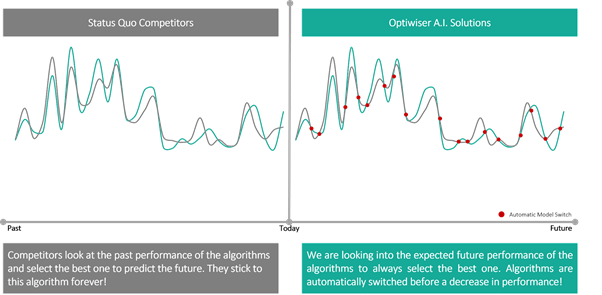Demand planning software: Why accurate demand planning is important
Demand Planning software – Abstract
In the following blog article, the importance of accurate demand planning is highlighted. The blog article starts with the definition of demand planning and its associated benefits. Current demand planning models are discussed and evaluated to understand why especially food and drink manufacturers rely on accurate demand planning. The reader will also be informed about the current state of the art in demand planning and how we as Optiwiser A.I. Solutions extend this status quo.
What is Demand Planning?
What quantity of products will be sold in the up-coming weeks, months and years? What are the short-term trends regarding my demand? What is the demand for the different sales channels? Which product groups could be interesting for my customers in six months’ time? These questions are of paramount importance to all companies. Almost all operational processes and functions depend on the answers to these questions: Purchasing, Inventory Management, Production Planning, Logistics, Sales and Marketing. The importance of demand forecasting is obvious, but what does demand planning actually mean and what is critical to obtaining an accurate forecast?
Demand planning is about predicting the future as accurately as possible. In most cases, future customer demand is predicted in order to understand the future development of demand and to be able to produce and deliver the product more efficiently and increase customer satisfaction. Demand planning is considered as an essential step in supply chain planning because supply chain planning typically starts with demand planning, which involves creating a demand plan based on statistical forecasts that consider factors that have an influence on demand, such as promotions, marketing and specifies where to distribute products to meet the anticipated demand. The rationale behind planning is to arrange decisions for future execution. Therefore, planning should always be looking into the future. As we often do not have complete information on future events, forecasts try to close the gap of the unknown. Unfortunately, we can never be 100% sure about the accuracy of forecasts. When uncertainty is involved, mistakes will be made and thus our forecast error will not be zero. Knowing that we are facing the fact of uncertainty, we can take care of this error in our planning activities by calculating safety stocks as an additional inventory buffer. In the next step, this information is then used for inventory optimization and for triggering the production.
Whether you are a manufacturer, wholesaler or retailer, demand forecasting is the most crucial operational process for your business. Inaccurate demand forecasts can have drastic consequences. For instance, if your demand planning tool is overpredicting, which means that the real demand is lower than the predicted demand, the overproduced products have to be stored in the warehouse. Consequently inventory levels increase and capital is tied up resulting in low cash flow. Food and beverage manufacturers in particular are severely affected, as they deal in perishable products. Thus, overstocking often leads to food waste. On the other hand whenever a demand planning software is predicting less than the real demand, so called “stock out” scenarios are the result, which means that the producer is not able to fulfill the required demand.
In this respect, estimating future customer demand as accurately as possible can be considered the starting point of all planning activities. Demand forecasting is therefore of utmost importance for the entire business performance and ensures the company’s profitability and customer satisfaction in the long term.
Why should enterprises use Demand Planning software?
Modern enterprises collect large amounts of data from daily sales processes and customer transactions across all distribution channels. Collectively, this data creates an enormous amount of data of valuable information. However, without practicing demand planning techniques, this insightful data just sits there and slowly begins to decay over time. Demand forecasting software collects and analyses sales data to identify dependent variables and trends in specific markets. With this quantitative evidence, the solution can predict future outcomes and allow companies to prepare their processes for the ebbs and flows of customer demand. Companies can use different types of demand forecasting depending on their market, product, and sales channels. Therefore, companies should consider how implementing demand forecasting solutions can improve their functionality and adaptability.
Demand forecasting uses historical and current data to predict fluctuating customer demand over a future period. Fundamental demand forecasting considers market, sales and inventory trends so that companies can improve their decision-making for various strategies, such as sourcing and pricing products. Through an understanding of potential sales patterns, companies can:
- Optimize budgeting, allocating capital to expand production, supply chain planning and business strategies to balance supply and demand
- Optimize inventory levels to increase turnover rates and minimize inventory costs
- Control of over- and underproduction
- Stakeholders can predict cash flow to create accurate budgets for the suppliers, operations, and expansion efforts
- Identify and resolve bottlenecks in the sales pipeline to ensure smooth operations throughout the supply chains
- Create accurate staffing plans to ensure that there are enough employees during the peak season
Solid demand planning is the basis for comprehensive supply chain planning and the resulting optimization of processes and KPIs.
What models can be used for Demand Planning?
To be able to classify the individual forecasting models, different categories allow a classification according to logic and application. Thus, forecasting models can be differentiated according to their methodological approach (qualitative and quantitative) and the forecast period (short, medium, or long-term). The qualitative methods often have little or no quantitative information on the object of the forecast, so that expert knowledge and verbal statements are used (e.g., estimation of sales staff or customer surveys). Reasons for the application of qualitative methods are for example missing information from the past (e.g., when a new product is launched) or structural discontinuities (e.g. new technologies or changed political conditions). This investigation implies that sufficient information is available to derive a forecast mathematically. In contrast to qualitative models, these models are based on mathematical rules and principles that calculate quantitative forecast results based on numerical historical values. In this regard, the fundamental assumption is that the demand of the past can be used to determine the demand of the future. The demand of the past is described by a time series, representing a chronological sequence of recorded observations. Considering the characteristic features of the time series, this sequence is projected into the future using appropriate forecasting models. The objective of the quantitative forecast can thus be defined as the updating of an existing time series. In quantitative forecasting, methods from statistics, machine learning and deep learning are used. Usually, the models are used for short and medium-term forecasting. Further, it is necessary to differentiate between univariate and multivariate forecasting models. With the latter, additional time-dependent, influencing factors and interrelations between different time series can be considered. When analyzing a time series, Wold’s decomposition theory is used, which states that each time series is composed of four components (trend component T, seasonal component S, cyclical component C and the residual component I). An actual demand pattern often results from the interference of these different components. The combination of the individual components can be additive or multiplicative so that different demand patterns are created based on the same component characteristics.
Why do food and drink producers strongly rely on AI-driven Demand Planning software?
Products offered by food and drink manufacturers have become interchangeable in most cases. To stay competitive and stand out from the competitors, companies have to focus on flexible customer service, speed and adherence to delivery dates at reasonable prices while trying to cut costs at the same time. The situation is enhanced by shortened product life cycles, dynamic customer behavior and the necessity to react immediately to volatile markets. These are just some of the challenges in this content. To become efficient in your supply chain it is crucial to implement efficient and sophisticated demand planning software that allows your company to prepare for future situations in advance. The available forecast algorithms in the literature as well as in commercial ERP systems are constantly increasing in terms of quantity and complexity. In addition, computing power and storage capacities have become significantly less expensive, which opens new possibilities in forecasting for companies. However, both quantitative and qualitative forecasting models are in some cases not suitable for producing a forecast of sufficient quality due to high market dynamics. Among other things, the increasing volume of data and an increasingly complex business environment are promoting uncertainties in forecasting. Uncertainties are partly sales-related and often the result of a lack of knowledge or incorrect information. Further, frequently changing product ranges and varying demand due to different interfering influencing factors (seasonal influences, price, and assortment policies etc.) are only a few of many factors that make it difficult to use conventional statistical forecasting models. In addition, the actual correlation between the influencing factors is often difficult to grasp or not recognizable by humans, which leads to an increased desire for and rising usage of artificial intelligence methods in demand planning.
To obtain a precise forecast, methods of Artificial Intelligence (AI) and the subcategories Machine Learning (ML) and Deep Learning (DL) are increasingly used. Both methods can be defined as sub-areas of artificial intelligence. The advantage of AI-based methods is that an automatic analysis of patterns and dependencies in the input data can be leveraged and used for the subsequent forecast. As is the case with statistical methods, there is no generally valid AI-based method that generates an improved forecast for every situation. Rather, each method can be used to achieve different qualities depending on the application.
Automated AI-driven demand planning software is the key element of a real time, connected supply chain and can boost your digital transformation. A positive example for supply chain excellence can be found by looking at Amazon. Many times, the speed of Amazon`s delivery is mind-blowing. But how is that even possible? The reason for this is the supply chain excellence of Amazon. They have already shipped the items you are likely to buy in the distribution centres in your area because they are thinking that you will order it. Magical as this sounds, it is the application of a very accurate AI-based demand planning software in the background which is analysing the historical data to determine where and when potential consumers will buy a product in what quantity before they do. AI-based demand planning software helps to get closer to your customers and understand their behaviour to prepare your supply chain for it.
What is Predictwiser.Clouds’ s USP compared to other AI-driven demand planning software tools?
Predictwiser.Cloud is an AI-driven demand planning software tailored to the needs of food and drink manufacturers. While there are several software solutions out there, Optiwiser A.I. Solutions stands out from the competition in terms of performance, price, implementation time and ease of use. We developed our product based on the “pain points” of our customers who were dissatisfied with the software solutions available on the market. From the idea to the implementation, creativity and technical know-how were required. Enrico Miranda, our CTO, holds a Master degree in Artificial Intelligence and Robotics and has been working in the industry for over 10 years. All his know-how went into the development of the tool and that’s what makes it so unique. One of our main USPs is our technology StreamWiser™ which is deeply embedded in the backend of our demand planning software. When it comes to choosing a forecasting technique, our approach strongly differs from the competitors. Choosing the right forecasting technique is usually a very complex task. It is not possible to easily look at a pattern of data and infer which techniques or which combination of parameters will work better.
Thus, choosing a forecasting technique is usually done by a selection of trial-and-error. Several models are trained on past data, and the model with the best performance on past data is usually selected as the best model. This selection is based on the underlying assumption that the past performance of the algorithm in all scenarios will lead to good future performances of the algorithm in any future scenario.

However, any breakdown of the predictions based on a longer historical period is bound to have limits on the representation of the forecasting. What if the best technique overall is not the best technique in the summer? Also, what if the best technique to predict Amazon sales is not the same as the best technique to predict sales on street stores? In this case, usually, these breakdowns generate a huge number of possible combinations. Since SMEs do not have the resources to work at such a detailed level, it is common to select the model with the best overall performance – even though this is not the best model always, for every case.
“Even though this is not the best model always” made us think about how to solve this problem and ensure that always the best algorithm is selected for the prediction at hand. The idea of our technology StreamWiser™ was born. As mentioned competitive software is selecting and training algorithms on a given past sales data set to find out which algorithm had the best performance. This algorithm is then chosen for the future predictions, although as we already know “this is not the best model always, for every case”.
StreamWiser™ allows us from today’s point to predict the future expected performance of the individual algorithms embedded in the backend of our demand planning software. Thus, it is always guaranteed that the best algorithms will be chosen for the underlying prediction. Looking at the right side of the figure above, a short example should help to understand the logic. The grey and petrol charts are showing the expected error rates of two different algorithms in the future. From today’s point of view StreamWiser™ would select the grey algorithm for predicting the demand. But as can be seen there comes a time when the grey algorithm is expected to have a lower error and thus our technology automatically switches to the grey algorithm before it comes to a performance decrease. Furthermore, this technology allows us to automatically find answers to the aforementioned questions like: “What is the best technique for predicting the summer? and What is the best algorithm for predicting the demand within different sales channels?


